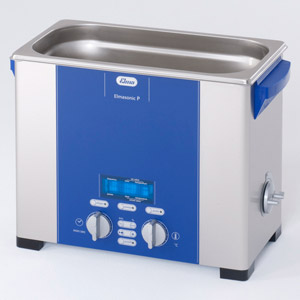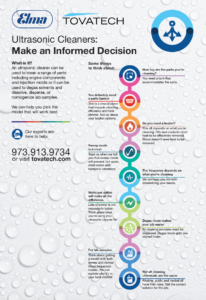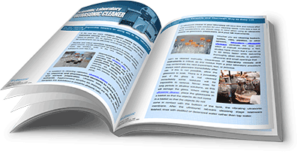Ultrasonic Cleaners Selection and Operating Tips
How you select an ultrasonic cleaner involves several points to consider and resolve before putting your money down. Today’s ultrasonic cleaners range from small benchtop or tabletop units with simple on-off switches to highly sophisticated cleaners with adjustable or controllable operating parameters that allow them to perform multiple cleaning tasks. Cleaning solution capacities can range from under one gallon for household or hobbyist applications to hundreds of gallons capable of cleaning automotive, marine and aircraft engines.
Cleaning solution chemistries as well are available in many, many formulations and should be carefully selected (and maintained) to provide optimum cleaning performance based on what is being cleaned and the nature of contaminants being removed. Most of today’s popular ultrasonic cleaning solution formulations are available as water-based concentrates and are biodegradable. These two features provide economies, simplify storage and reduce, if not eliminate, disposal concerns. The problems and challenges associated with trichloroethylene and perchlorethylene cleaning solvents used in the past no longer apply.
How Ultrasonic Cleaners Work
You may have heard of, or know how efficient ultrasonic energy is when it comes to cleaning products. Here’s a quick capsule on how ultrasonic cleaners work.
An ultrasonic cleaner includes a cleaning solution tank to which are bonded ultrasonic transducers that are powered by the unit’s ultrasonic generator.
Transducers are generally bonded under the tank bottom although some cleaners have them bonded to the sides. There are also transducers that are immersed in the tank – sometimes called “shoebox” transducers. Wherever or however they are placed, their function is the same.
Most ultrasonic cleaners are designed to operate at specific ultrasonic frequencies (see below) although models are available that operate at dual frequencies. When activated transducers vibrate at their assigned frequency causing the bottom of the tank to vibrate as a membrane and create billions of microscopic vacuum bubbles pulsing through the solution. When the bubbles implode they release a powerful jet of liquid (the cleaning solution) that blasts contaminants from products being cleaned. The process is called ultrasonic cavitation.
When we say powerful we mean just that. Shock waves may be on the order of 15,000 to 150,000 psi and at temperatures of 5,000 to 10,000⁰C. Yet the process is so fast that sonic cleaning is safe when the correct frequencies are used. That said, never reach into an operating ultrasonic bath.
As noted above, ultrasonic cleaners range from simple units with an on-off switch to those equipped with timers, temperature controls, adjustable ultrasonic power, selectable ultrasonic frequencies and with the capability of slightly agitating cleaning baskets to improve cleaning action.
What Ultrasonic Frequency Should I Use?
Ultrasonic cleaner manufacturers such as Elma, available from Tovatech, specify operating frequencies in kilohertz (kHz) or thousands of cycles per second. Popular cleaners operate at 37 or 45 kHz; other units operate at frequencies such as 25, 80 or 130 kHz.
Frequency selection can be important, depending on what is being cleaned. A low frequency such as 25 kHz produces (relatively) large cavitation bubbles that implode with much more violence than high frequencies such as 80 and 130 kHz. Low frequency cavitation is ideal for heavily soiled components such as fabricated and cast metal parts. Delicate and highly polished surfaces should be cleaned at higher frequencies such as 80 or 130 kHz. Higher frequencies are also recommended when cleaning parts of complex shape and those with cracks, crevices, blind and machined holes. That is because the smaller bubbles are better able to penetrate these difficult-to-reach areas.
The vast majority of cleaning operations can be performed with equipment operating at 37 or 45 kHz. Dual-frequency ultrasonic cleaners are a good choice if you clean a variety of products with differing characteristics.
What Size Cleaner Should I Use?
First of all, the vast majority of ultrasonic cleaning operations are performed when parts are placed in baskets. That’s because parts being cleaned should not be in contact with the tank bottom or sides. Otherwise sonic vibrations of the parts will quickly damage the tank. The only exceptions are if parts are suspended in the cleaning solution or when tanks are fabricated with a bottom rack, such as in the case of some large industrial cleaners.
Back to our first point: Basket dimensions are smaller than tank dimensions in terms of length, width and depth. You’ll want to specify an ultrasonic cleaner tank size based on the corresponding basket size that will accommodate the parts to be cleaned.
Added to that, parts to be cleaned must be totally immersed in the cleaning solution. Because of this you must consider what is called the working depth of the cleaning solution. This is defined as the distance from the inside bottom surface of the basket to the surface of the liquid in a filled tank. If the working depth of the equipment you are considering is not provided or unclear from the specs, ask the manufacturer.
As a special note, if you are cleaning small parts such as machined screws you can purchase fine mesh baskets that can be placed in standard baskets. Or you can put the parts in glass beakers containing cleaning solution and place the beakers in the basket. In this case ultrasound penetrates the glass allowing cavitation to work on the small parts.
Ultrasonic Cleaner Bells and Whistles
As we noted earlier ultrasonic cleaners range from those with an on-off button to sophisticated equipment enabling users to perform multiple cleaning tasks. Here are some examples of features that may be useful.
- Degas quickly drives off cavitation-inhibiting trapped air from fresh cleaning solutions. This also can be accomplished by operating a cleaner without a load but in large capacity cleaners it can take an excessive amount of time.
- Sweep is a slight ± variation in ultrasonic frequency to provide more uniform cleaning throughout the solution.
- Pulse is activated to deliver intermittent spikes of very high ultrasonic power to remove stubborn contaminants. Pulse can also be used to degas the solution.
- Heaters help boost cleaning efficiency for parts contaminated with coolants and other oily contaminants. Heaters may be thermostatically adjustable to a maximum of 80⁰C above which cavitation is inhibited and cleaning efficiency levels off. Heat is also a natural byproduct of cavitation. (In certain cases an optional cooling coil may be required to help keep solution temperatures within recommended bounds.)
- Adjustable power can deliver faster and more effective cleaning but more power is not always better. Too much can damage soft metal surfaces such as polished surfaces of soft metals such as aluminum and other delicate items. Ultrasonic cleaners offering adjustable power are useful when cleaning a variety of surfaces including extremely sensitive items.
- Parts agitation during ultrasonic cleaning increases cleaning speed and efficiency. For example, gentle vertical oscillation of the cleaning basket ± 2 cm can increase cleaning speed by 10 – 20% and improve cleaning uniformity.
How to Select Ultrasonic Cleaning Solutions
Cleaning solution chemistry is as important as ultrasonic frequency, power and other points covered in this post. Most commonly used chemistries fall into three categories: alkaline, acidic and neutral. They are usually supplied as concentrates so a little goes a long way. When formulated with non-toxic biodegradable ingredients disposal concerns are eased. Manufacturers provide dilution and cleaning temperature recommendations.
Because most solutions are water based there may be a concern about rusting. Rust inhibitors can be added to address this.
How Much Solution Should I Use?
Good question and it’s an important one.
Most ultrasonic cleaners have a fill line or other designation indicating the maximum solution level. You’ll get the best results when cleaning with a full tank. But equally important is what is called the service volume. This is the volume of solution needed to accommodate displacement by parts being cleaned when fully immersed. Stated otherwise, when you place the basket of parts in the tank the solution should rise to the fill line. Service volume specifications are provided in user manuals.
Know this: Overfilling the tank does not improve efficiency; under filling the tank does not intensify cleaning and can damage the tank. This is why the service volume designation is important. It allows safe solution mixing, degassing and heating when baskets are empty.
Here’s a suggested procedure to accommodate varying displacement when cleaning different products: Prepare fresh solutions for a full tank. Fill it half way with water, add the correct amount of cleaning solution concentrate for a full tank, then fill the tank and activate the ultrasound and degas mode to mix and degas the solution. You can draw off and store excess quantity to accommodate displacement.
How to Extend Cleaning Solution Lifetime
Cleaning effectiveness is extended when solutions are maintained. Skim off and set aside oily contaminants that float to the surface. If you are using larger tanks select those equipped with spray bars and weirs to handle this. Filtration systems are available for large tanks to trap contaminants that damage the tank if allowed to settle and remain on the bottom.
Eventually, however, all solutions must be replaced by draining the tank and abiding by local disposal regulations. Clean the tank following user manual instructions.
Post-Cleaning Steps
Product rinsing and drying may be required to remove solution residues prior to subsequent steps. Rinsing spray stations, rinsing tanks and hot air dryers can be employed to accomplish this. Contact vendors for equipment options.
Other Operating Tips
Although you can’t hear ultrasonic frequencies, ultrasonic cleaners, especially those operating at lower frequencies, do create noise due to tank wall vibrations. Cover the tank to reduce this noise and reduce solution evaporation. Placing tanks in sound-deadening enclosures and using sound-suppression ear protection may also be advised. Some units may be offered with insulated lids to reduce the noise.
Cleaning with Volatile Solvents
When cleaning products that that are sensitive to water or require the absence of residues flammable solvents such as acetone, IPA, MEK and toluene are often employed.
Special equipment is required when using flammable solvents. To address this explosion-proof ultrasonic cleaners should be employed. Available from Tovatech these cleaners carry an Explosion Proof label and comply with OSHA standards along with NEC and NFPA guidelines.
They are rated explosion proof because their construction completely isolates potential spark-generating system electronics from contact with solvent vapors or spilled solvent. They are available with tank capacities from under a gallon up to 90 gallons but are not equipped with heaters.
Important Safety Points
Operating explosion-proof ultrasonic cleaners create a hazardous area due to cleaning solvent fumes. Fumes must be vented using approved ventilation systems. All electrical equipment, wiring, lighting fixtures, outlets and similar equipment must be rated as intrinsically safe by the National Electric Code, NFPA-70 Articles 500-503.
As a second point, because solvents evaporate quickly operators must maintain a solvent level greater than half the tank capacity or risk damaging the ultrasonic transducers.
In Conclusion
This post covers many considerations on selecting ultrasonic cleaning systems. Once equipment is in place you’ll gain experience on preparing the correct amount of cleaning solution for jobs being done, optimum cleaning solution temperatures and cleaning times. When routines are established ultrasonic cleaners can be programmed by time, temperature, frequency and other variables depending on features the equipment offers.
Call the scientists at Tovatech for unbiased help in selecting equipment, cleaning solution formulations and operating procedures that will help you do the job quickly and efficiently.



